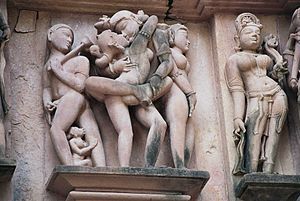
Back الجنس والدين Arabic Relihiyon asin sekswalidad BCL Рэлігія і сэксуальнасьць BE-X-OLD ধর্ম ও যৌনতা Bengali/Bangla ཆོས་ལུགས་དང་འདོད་ཆགས། Tibetan Náboženství a sexualita Czech Religión y sexualidad Spanish دین و تمایلات جنسی Persian Uskonto ja seksuaalisuus Finnish Spolnost i kršćanstvo Croatian

The views of the various different religions and religious believers regarding human sexuality range widely among and within them, from giving sex and sexuality a rather negative connotation to believing that sex is the highest expression of the divine.[1] Some religions distinguish between human sexual activities that are practised for biological reproduction (sometimes allowed only when in formal marital status and at a certain age) and those practised only for sexual pleasure in evaluating relative morality.
Sexual morality has varied greatly over time and between cultures. A society's sexual norms—standards of sexual conduct—can be linked to religious beliefs, or social and environmental conditions, or all of these. Sexuality and reproduction are fundamental elements in human interaction and societies worldwide. Furthermore, "sexual restriction" is one of the universals of culture peculiar to all human societies.[2][3]
Accordingly, most religions have seen a need to address the question of a "proper" role for sexuality. Religions have differing codes of sexual morality, which regulate sexual activity or assign normative values to certain sexually charged actions or ideas. Each major religion has developed a moral code covering issues of human sexuality, morality, ethics, etc. These moral codes seek to regulate the situations that can give rise to sexual interest and to influence people's sexual activities and practices.
- ^ Urban, Hugh B. (2010). "Chapter 4 – The Sacrifice of Desire: Sexual Rites and the Secret Sacrifice". The Power of Tantra: Religion, Sexuality, and the Politics of South Asian Studies. London and New York: I.B. Tauris. pp. 99–124. doi:10.5040/9780755625185.ch-004. ISBN 978-0-7556-2518-5.
- ^ George P. Murdock. "On the universals of culture". In: Linton (ed), The Science of Man in the World Crisis (1945).
- ^ Alice Ann Cleaveland, Jean Craven, Maryanne Danfelser. Universals of Culture. Center for Global Perspectives, 1979.